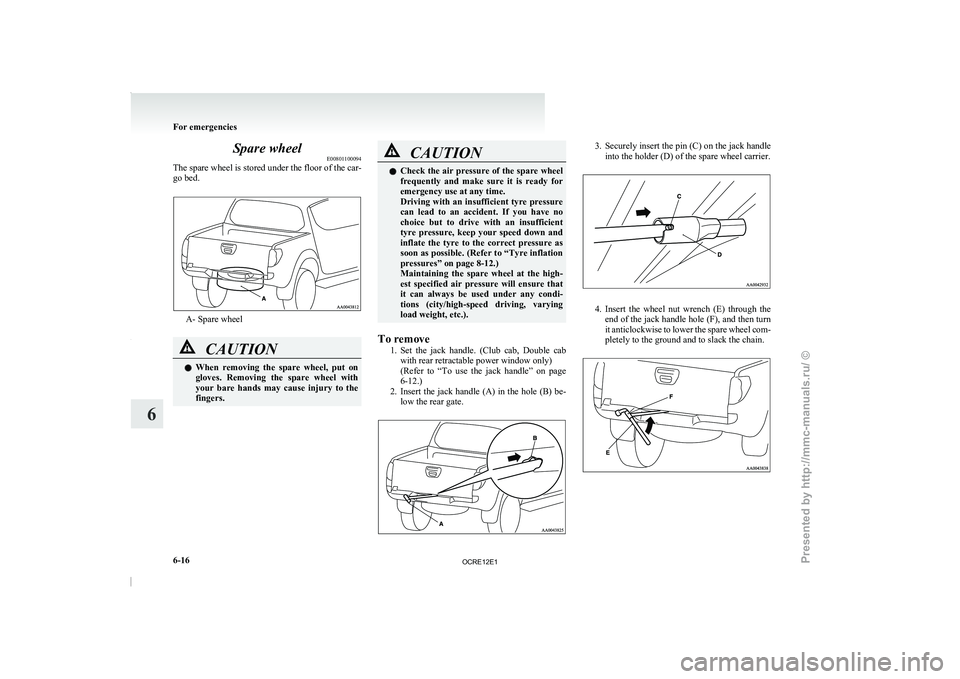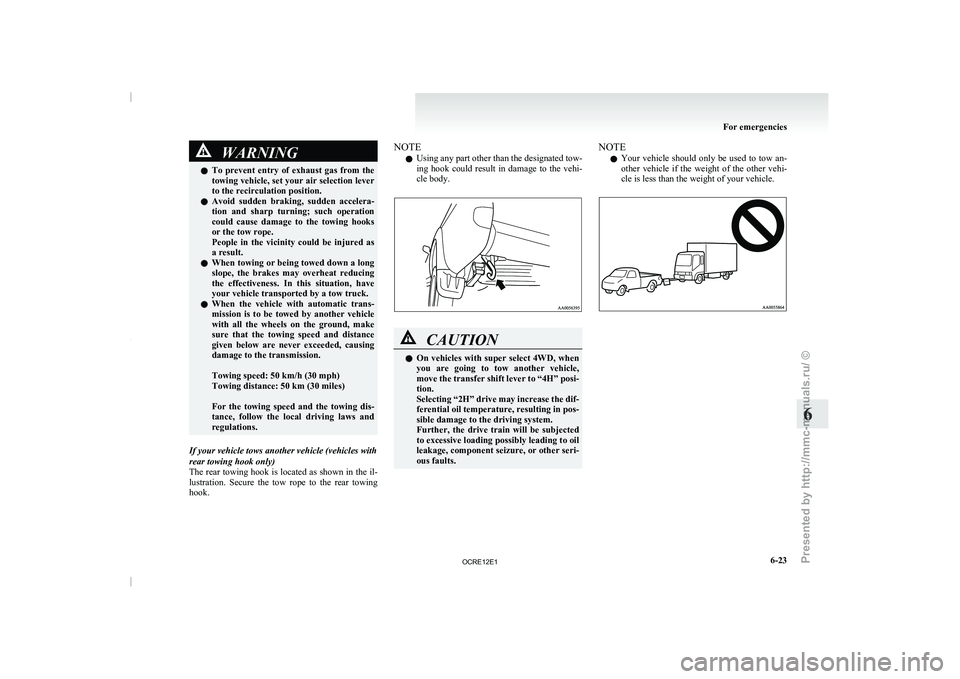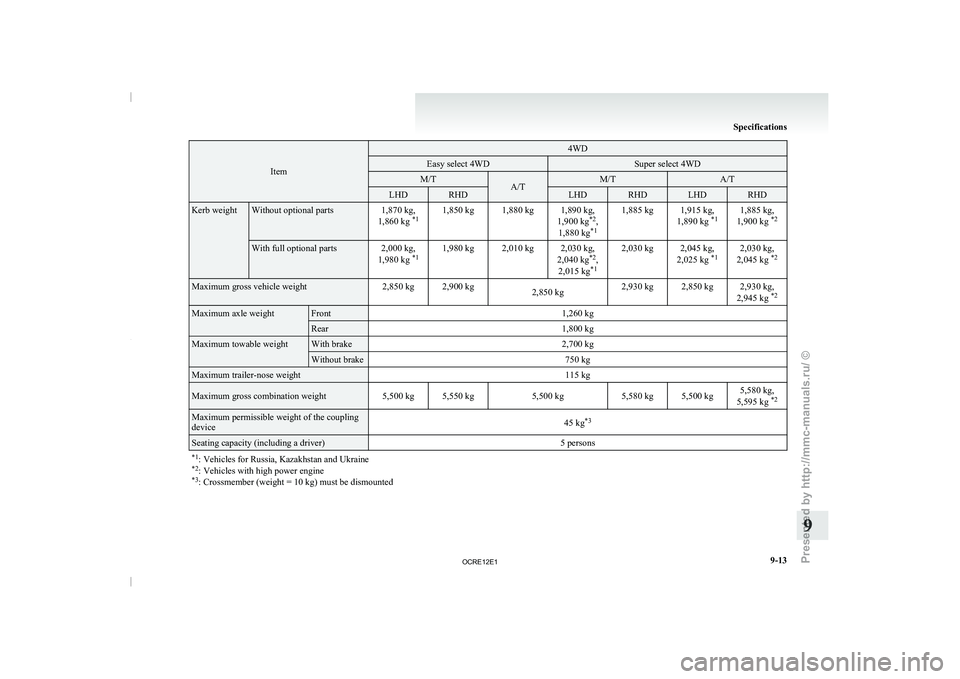Page 181 of 369

Club cab Single cab, Double cab (Vehicles without long bed) Double cab (Vehicles with long bed)
1
30 mm 30 mm30 mm2
55 mm 55 mm55 mm3
115 mm 60 mm60 mm4
872 mm 812 mm812 mm5
20 mm 20 mm20 mm6
85 mm 85 mm85 mm7
686 - 699 mm 681 - 689 mm, 580 - 583 mm* 681 - 683 mm, 578 mm*8
642 - 654 mm 639 - 647 mm, 538 - 541 mm* 639 - 641 mm, 536 mm*9
612 - 624 mm 609 - 617 mm, 508 - 511 mm* 609 - 611 mm, 506 mm*10
406 - 419 mm 400 - 409 mm, 292 - 297 mm* 395 - 415 mm, 305 mm*11
485 - 500 mm 479 - 489 mm, 486 - 491 mm* 475 - 494 mm, 489 mm*12
897 mm 897 mm897 mm13
1,251 mm 1,136 mm1,316 mm14
70 mm 70 mm70 mm15
502.5 mm 502.5 mm502.5 mm16
540.5 mm 540.5 mm540.5 mmItem 7, 8, 9, 10, 11: at kerb weight
*: 2WD vehicles with 15 inch tyres
NOTE
l The
values under item 7,
8, 9, 10, 11 are ap-
plicable to unladen vehicles. These values
can also be varied depending on the tyre size,
optional equipment and suspension condi-
tions. Operating hints
l Do
not let the
clutch
slip (vehicles with a M/
a only) and do not increase the engine speed
more than necessary when starting.
l Be sure that the driving speed does not ex-
ceed the maximum speed for trailer operation.
l To prevent shocks from the overrun brake, de-
press the brake pedal lightly at first and then
more strongly. l
To make full use
of engine braking, change
to a lower gear before descending a slope.
l The body, brakes, clutch, and chassis will be
under additional strain when towing a trailer.
l The heavier weight and higher rolling and air
resistance will increase fuel consumption. Starting and driving
4-56
4
OCRE12E1
Presented by http://mmc-manuals.ru/ \251
Page 281 of 369

Spare wheel
E00801100094
The spare wheel is stored
under the floor of the car-
go bed. A- Spare wheel
CAUTION
l
When removing the spare
wheel,
put on
gloves. Removing the spare wheel with
your bare hands may cause injury to the
fingers. CAUTION
l
Check the air pressure of
the spare wheel
frequently and make sure it is ready for
emergency use at any time.
Driving with an insufficient tyre pressure
can lead to an accident. If you have no
choice but to drive with an insufficient
tyre pressure, keep your speed down and
inflate the tyre to the correct pressure as
soon as possible. (Refer to “Tyre inflation
pressures” on page 8-12.)
Maintaining the spare wheel at the high-
est specified air pressure will ensure that
it can always be used under any condi-
tions (city/high-speed driving, varying
load weight, etc.).
To remove 1. Set the jack handle. (Club
cab, Double cab
with rear retractable power window only)
(Refer to “To use the jack handle” on page
6-12.)
2. Insert the jack handle (A) in the hole (B) be- low the rear gate. 3. Securely insert the pin (C) on the jack handle
into the holder (D) of the spare wheel carrier. 4. Insert the wheel nut wrench (E) through the
end of the jack
handle hole (F), and then turn
it anticlockwise to lower the spare wheel com-
pletely to the ground and to slack the chain. For emergencies
6-16
6
OCRE12E1
Presented by http://mmc-manuals.ru/ \251
Page 288 of 369

WARNING
l To prevent entry of exhaust gas from the
towing vehicle, set your air selection lever
to the recirculation position.
l Avoid sudden braking, sudden accelera-
tion and sharp turning; such operation
could cause damage to the towing hooks
or the tow rope.
People in the vicinity could be injured as
a result.
l When towing or being towed down a long
slope, the brakes may overheat reducing
the effectiveness. In this situation, have
your vehicle transported by a tow truck.
l When the vehicle with automatic trans-
mission is to be towed by another vehicle
with all the wheels on the ground, make
sure that the towing speed and distance
given below are never exceeded, causing
damage to the transmission.
Towing speed: 50 km/h (30 mph)
Towing distance: 50 km (30 miles)
For the towing speed and the towing dis-
tance, follow the local driving laws and
regulations.
If your vehicle tows another vehicle (vehicles with
rear towing hook only)
The rear towing hook is
located as shown in the il-
lustration. Secure the tow rope to the rear towing
hook. NOTE
l Using
any part
other than
the designated tow-
ing hook could result in damage to the vehi-
cle body. CAUTION
l
On
vehicles with
super select
4WD, when
you are going to tow another vehicle,
move the transfer shift lever to “4H” posi-
tion.
Selecting “2H” drive may increase the dif-
ferential oil temperature, resulting in pos-
sible damage to the driving system.
Further, the drive train will be subjected
to excessive loading possibly leading to oil
leakage, component seizure, or other seri-
ous faults. NOTE
l Your
vehicle should only be
used to tow an-
other vehicle if the weight of the other vehi-
cle is less than the weight of your vehicle. For emergencies
6-23 6
OCRE12E1
Presented by http://mmc-manuals.ru/ \251
Page 332 of 369

Vehicle labeling
............................................................................ 9-02
Vehicle dimensions....................................................................... 9-03
Vehicle performance.....................................................................9-09
Vehicle weight .............................................................................. 9-10
Engine specifications .................................................................... 9-15
Transmission specifications .......................................................... 9-16
Electrical system ........................................................................... 9-17
Tyres and wheels.......................................................................... 9-18
Other specifications ...................................................................... 9-19
Fuel consumption ......................................................................... 9-20
Refill capacities ............................................................................ 9-22Specifications
9
OCRE12E1
Presented by http://mmc-manuals.ru/ \251
Page 341 of 369

Vehicle weight
E01100404900
Single cab Item 2WD 4WD
LHD RHD
Kerb weight Without optional parts
1,565 kg, 1,550 kg *1
1,780 kg 1,770 kg With full optional parts
1,595 kg, 1,600 kg *1
1,840 kg 1,810 kgMaximum gross vehicle weight
2,630 kg2,850 kg2,890 kgMaximum axle weight Front
1,030 kg1,260 kg Rear
1,700 kg1,800 kgMaximum towable weight With brake
1,800 kg *2
2,700 kg Without brake
750 kg *2 Maximum trailer-nose weight
77 kg *2
115 kgMaximum gross combination weight
4,400 kg *2
5,500 kg 5,540 kgMaximum permissible weight of the coupling device
35 kg*2
45 kg*3 Seating capacity (including a driver)
2 persons, 3 persons*4
*1 : Vehicles for Morocco
*2 : Except for vehicles for Morocco
*3 : Crossmember (weight = 10 kg) must be dismounted
*4 : Vehicles equipped with bench seat NOTE
l Trailer specifications indicate the manufacturer’s recommendation.
l When loading luggage and/or towing a trailer, make sure not to exceed any of the above maximum weights all the time. Specifications
9-10
9
OCRE12E1
Presented by http://mmc-manuals.ru/ \251
Page 342 of 369
Club cab
Item Easy select 4WD
Super select 4WD
LHD RHD
Kerb weight
Without optional parts
1,800 kg
1,800 kg
1,815 kg, 1,825 kg *1 With full optional parts
1,900 kg
1,880 kg
1,910 kg, 1,920 kg *1Maximum gross vehicle weight
2,850 kgMaximum axle weight Front
1,260 kgRear
1,800 kgMaximum towable weight With brake
2,700 kgWithout brake
750 kgMaximum trailer-nose weight
115 kgMaximum gross combination weight
5,500 kgMaximum permissible weight of the coupling device
45 kg*2 Seating capacity (including a driver)
4 persons
*1 : Vehicles with high power engine
*2 : Crossmember (weight = 10 kg) must be dismounted NOTE
l Trailer specifications indicate the manufacturer’s recommendation.
l When loading luggage and/or towing a trailer, make sure not to exceed any of the above maximum weights all the time. Specifications
9-11 9
OCRE12E1
Presented by http://mmc-manuals.ru/ \251
Page 343 of 369
Double cab
Item 2WD
M/T
A/T
Vehicles with 15 inch
tyres Vehicles with 16 inch
tyres Kerb weight Without optional parts
1,665 kg1,770 kg1,780 kg With full optional parts
1,735 kg1,900 kg1,910 kgMaximum gross vehicle weight
2,630 kg2,800 kgMaximum axle weight Front
1,030 kg 1,260 kg Rear
1,700 kg 1,800 kgMaximum towable weight With brake
1,800 kg 2,700 kg Without brake
750 kgMaximum trailer-nose weight
75 kg112 kgMaximum gross combination weight
4,400 kg5,465 kgMaximum permissible weight of the coupling device
35 kg
45 kg* Seating capacity (including a driver)
5 persons
* : Crossmember (weight = 10 kg) must be dismounted NOTE
l Trailer specifications indicate the manufacturer’s recommendation.
l When loading luggage and/or towing a trailer, make sure not to exceed any of the above maximum weights all the time. Specifications
9-12
9
OCRE12E1
Presented by http://mmc-manuals.ru/ \251
Page 344 of 369

Item 4WD
Easy select 4WD Super select 4WD
M/T
A/T M/T A/T
LHD RHD LHD RHD LHD RHD
Kerb weight Without optional parts
1,870 kg,
1,860 kg *11,850 kg 1,880 kg 1,890 kg,
1,900 kg*2
,
1,880 kg *11,885 kg 1,915 kg,
1,890 kg *11,885 kg,
1,900 kg *2 With full optional parts 2,000 kg,
1,980 kg *11,980 kg 2,010 kg 2,030 kg,
2,040 kg*2
,
2,015 kg *12,030 kg 2,045 kg,
2,025 kg *12,030 kg,
2,045 kg *2 Maximum gross vehicle weight
2,850 kg 2,900 kg
2,850 kg2,930 kg 2,850 kg 2,930 kg,
2,945 kg *2 Maximum axle weight Front
1,260 kgRear
1,800 kgMaximum towable weight With brake
2,700 kgWithout brake
750 kgMaximum trailer-nose weight
115 kgMaximum gross combination weight
5,500 kg 5,550 kg5,500 kg5,580 kg 5,500 kg 5,580 kg,
5,595 kg *2 Maximum permissible weight of the coupling
device
45 kg
*3 Seating capacity (including a driver)
5 persons
*1 : Vehicles for Russia, Kazakhstan and Ukraine
*2 : Vehicles with high power engine
*3 : Crossmember (weight = 10 kg) must be dismounted Specifications
9-13 9
OCRE12E1
Presented by http://mmc-manuals.ru/ \251